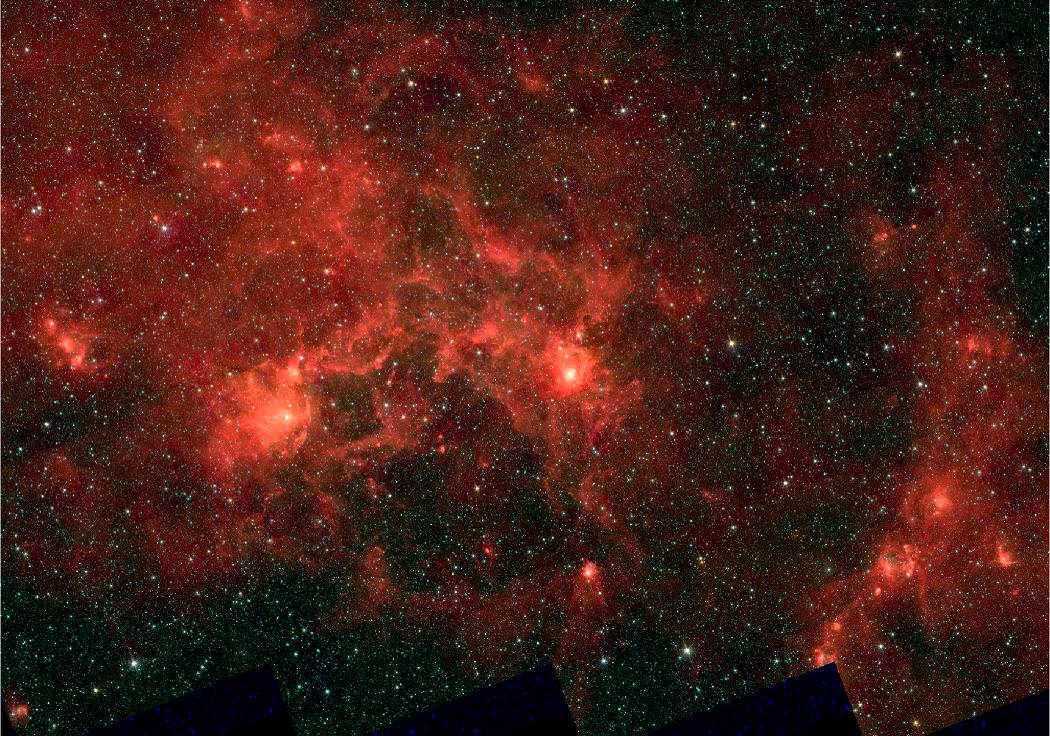[/caption]
At the University of Toronto, a trio of astronomers have been fishing – fishing for a copious catch of young, supermassive stars. What they caught was unprecedented… Hundreds of thousands of stars with several hundreds of these being the most massive kind. They hauled in blue stars dozens of times heavier than the Sun, with light so intense it ate its way through the gas that created it. All that’s left is the hollow egg-shell… A shell that measures a hundred light years across.
Their work will be published in the December 20 issue of the Astrophysical Journal Letters, but the team isn’t stopping there. The next catch is waiting. “By studying these supermassive stars and the shell surrounding them, we hope to learn more about how energy is transmitted in such extreme environments,” says Mubdi Rahman, a PhD candidate in the Department of Astronomy & Astrophysics at the University of Toronto. Rahman led the team, along with supervisors, Professors Dae-Sik Moon and Christopher Matzner.
Is the discovery of a huge factory for massive stars new? No. Astronomers have picked them up in other galaxies, but the distance didn’t allow for a clear picture – even when combined with data from other telescopes. “This time, the massive stars are right here in our galaxy, and we can even count them individually,” Rahman says.
However, studying this bright stellar cache isn’t going to be an easy task. Since they are located some 30,000 light years away, the measurements will be extremely labor intensive due to intervening gas and dust. Their light is absorbed, which makes the most luminous of them seem to be smaller and closer. To make matters worse, the fainter stars don’t show up at all. “All this dust made it difficult for us to figure out what type of stars they are,” Rahman says. “These stars are incredibly bright, yet, they’re very hard to see.”
By employing the New Technology Telescope at the European Southern Observatory in Chile, the researchers gathered as much light as possible from a small collection of stars. From this point, they calculated the amount of light each star emitted across the spectrum to determine how many were massive. At least twelve were of the highest order, with a few measuring out to be around a hundred times more massive than the Sun. Before researching the area with a ground-based telescope, Rahman used the WMAP satellite to study the microwave band. There he encountered the glow of the heated gas shell. Then it was Spitzer time… and the imaging began in infra-red.
Once the photos came back the picture was clear… Rahman noticed the stellar egg-shell had a striking resemblance to Peter Shearer’s illustration “The Dragonfish”. And indeed it does look like a mythical creature! With just a bit of imagination you can see a tooth-filled mouth, eyes and even a fin. The interior of the mouth is where the gas has been expelled by the stellar light and propelled forward to form the shell. Not a sight you’d want to encounter on a dark night… Or maybe you would!
“We were able to see the effect of the stars on their surroundings before seeing the stars directly,” Rahman says. This strange heat signature would almost be like watching a face lit by a fire without being able to see the fueling source. Just as red coals are cooler than blue flame, gas behaves the same way in color – with much of it in the infra-red end of the spectrum and only visible to the correct instrumentation. At the other end of the equation are the giant stars which emit in ultra-violet and remain invisible in this type of image. “But we had to make sure what was at the heart of the shell,” Rahman says.
With the positive identification of several massive stars, the team knew they would expire quickly in astronomical terms. “Still, if you thought the inside of the shell was empty, think again,” explains Rahman. For every few hundred superstars, thousands of ordinary stars like the Sun also exist in this region. When the massive ones go supernova, they’ll release metals and heavy atoms which – in turn – may create solar nebulae around the less dramatic stars. This means they could eventually form solar systems of their own
“There may be newer stars already forming in the eyes of the Dragonfish,” Rahman says. Because some areas of the shell appear brighter, researchers surmise the gases contained there are possibly compressing enough to ignite new stars – with enough to go around for many more. However, when there’s no mass or gravity to hold them captive, it would seem they want to fly the nest. “We’ve found a rebel in the group, a runaway star escaping from the group at high speed,” Rahman says. “We think the group is no longer tied together by gravity: however, how the association will fly apart is something we still don’t understand well.”
Original Story Source: In The Dragonfish’s Mouth: The Next Generation Of Superstars To Stir Up Our Galaxy.

